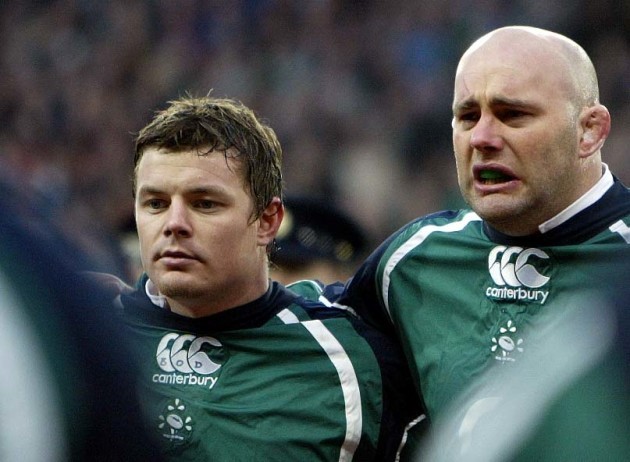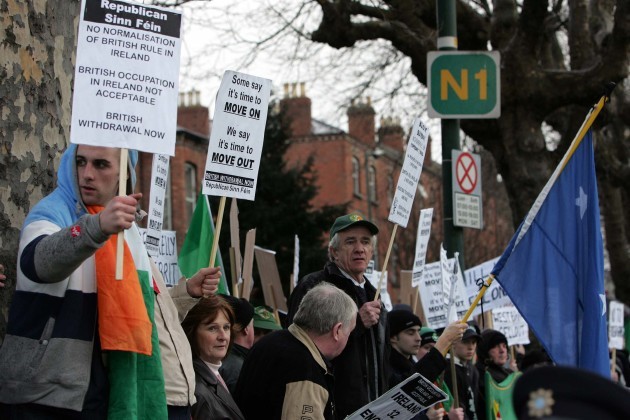Click here for more of The42′s Ireland v England anniversary series >
PLAYING NATIONAL ANTHEMS before sports events was nothing new for the Army No. 1 Band coming into the 2007 Six Nations campaign.
Over the years, they learned to become proficient at performing them in the old arena at Lansdowne Road.
It was a familiar space, where the band members would often slip into the seats to watch the game after finishing their performance.
But during the reconstruction phases preceding the birth of the Aviva Stadium, the band was redirected to a new setting for their anthem-playing duties — Croke Park.
This wasn’t entirely uncharted territory for the group. They had previously deputised for the Artane Band at the stadium in the past.
But covering this particular set of Six Nations gigs was about more than just carrying out the anthems in a different stadium.
Following the amendment of Rule 42, the people of Ireland were conflicted, and finding it difficult to unanimously support the concept of hosting rugby and football games at GAA headquarters.
With England lined up to be one of the teams coming to Ireland that year, there were concerns over how a rendition of God Save The Queen would be received.
There was still a lingering resonance with the events of Bloody Sunday in 1920, and some pockets of society felt the doors of Croke Park were being prematurely reopened to the British.
Mark Armstrong, who was the Army No.1 Band conductor at that time, could appreciate the tension surrounding the fixture.
“With a sporting event like Ireland v England, and their old rivalry — a healthy rivalry of course — there was a lot of good sensibilities surrounding it, which maybe people were slightly anxious about, with the anthem being played there,” he told The42.
“Obviously, we played the British anthem before in Lansdowne Road, but it was the location of Croke Park that was the significant part of it.”
Of course, this wasn’t the first Six Nations game to be hosted at the grounds in 2007. Ireland had a home tie with France ahead of the England clash, but Armstrong never gets inquiries about his memories of that fixture.
The lack of a deeply-rooted tension between Ireland and France must have dampened the intrigue.
But the France game allowed Armstrong, and the rest of the band, to acclimatise to an atmosphere which didn’t manifest in the more compact surroundings of Lansdowne Road.
Looking back, because the capacity is around 80,000, the sheer volume of support and the sound was something that we’d never been used to, so it was exceptional from that point of view.
“There was huge interest and I suppose the novelty value of rugby being played in Croke Park. There was a different atmosphere altogether, people were so used to the old Lansdowne Road.”
The England match took place on 24 February, but neither Armstrong, nor the band members, were worried about any dangerous scenarios occurring in the stadium.
The subject of the game and the historical context of it all inevitably came up in conversation, but their focus was solely on the music.
We’re there to do a job. It’s a job that we were so used to doing because we play at an awful lot of international sports events. I think there was a heightened awareness of the occasion itself and a great anticipation.
“They (the band members) enjoy those occasions as well. There was an awful lot of talk about it between ourselves in the run up to it.”
The disapproving minority were present on the day, although they refrained from committing any malicious acts.
The band spotted a few protesters outside the stadium, but the images of those dissenters have all but left Armstrong’s memory of the day.
“That’s kind of all been forgotten about because the event was so great. Everybody had so much respect in the stadium.
“There was a huge spirit and such good behaviour as well. That particular crowd understood how important it was that everybody respected each other’s traditions. And of course, they went on to have a great rugby match.”
The Army band was tasked with performing Amhrán na bhFiann and Ireland’s Call, while the Garda Band was entrusted with delivering God Save The Queen.
Standing behind the procession of players on the pitch minutes before kick-off, Armstrong got a full flavour of what was unfolding.
He explains how the symbolic nature of the occasion added another layer of responsibility to their assignment.
“You’re very aware because you’ve just had the President (Mary McAleese) over to review the two teams lined up. We’re actually behind that, so you know what’s going and we’re all keenly aware of the players too.
You’re the musical support for 80,000 people singing the national anthem so it’s a great responsibility and a great honour as well. I felt very proud. It’s a combination of emotions that you really can’t describe.”
He added: “I was very interested to see how loudly they would sing because it was a completely different situation. I couldn’t believe the noise that came out of the crowd when they sang God Save The Queen, which would have been the first anthem.
“It struck me that everyone in the stadium seemed to be singing along, which of course probably wasn’t true. But somebody said to me afterwards that there was a YouTube video taken up in the stands and there were Irish people signing along as well, so maybe I’m not that far off the mark.”
The national anthem has always evoked a powerful emotion in Armstrong. From his early days of conducting the band, he felt a profound response to the songs that represent our national identity and heritage.
I remember the very first time I walked as a young band conductor onto Lansdowne Road. The first thing that hit me was the colour of the grass, it’s so green.
“And then of course, you’re playing the national anthem, you’re in the middle of the pitch, and you’re hearing all of this sound coming in around you.”
Over time, he developed an understanding of how to pace the song so that spectators can enjoy the experience in full voice. And he applies that method every time he conducts the band, regardless of the name above the stadium.
“I discovered there was a certain tempo to play the national anthem at, which allowed the crowd to keep up. There’s a pause at the very end of the national anthem, and if you keep going too fast, you lose everybody.
“I remember the first time I did it and I was hugely proud to be there. My father was alive at the time and he was a great rugby fan so he was delighted to see me doing that.”
Subscribe to The42 Rugby Show podcast here:



